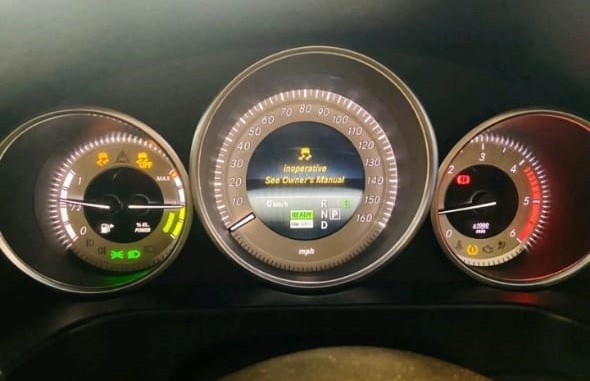Table of Contents
ESP Inoperable Mercedes: A Case Study in the Mercedes E300 W212
Vehicle: Mercedes Benz E300
Complaint: Vehicle brake system not working.
A Mercedes E300 W212 recently arrived at our workshop with an alarming issue: an ESP Inoperable Mercedes warning displayed prominently on the dashboard. The Electronic Stability Program (ESP) is a crucial system that ensures vehicle safety by preventing skidding and maintaining control, especially during challenging driving conditions. Therefore, an inoperable ESP is a serious concern that needed immediate attention.

Diagnostic Process:
Upon receiving the vehicle, I began with a thorough diagnostic check. The scan revealed multiple faults within the ESP Control Module, particularly related to the vacuum system. The vacuum system plays an integral role in the operation of the ESP, as it helps maintain the necessary pressure for brake assistance and other functions.


Investigation and Repair:
Understanding the gravity of the situation, I decided to delve into the vacuum system, starting with the vacuum pump. To my surprise, I found that there was no aspiration from the pump. The absence of suction indicated that the vacuum pump was malfunctioning and needed to be replaced.

I proceeded to replace the faulty vacuum pump with a new one, ensuring that all connections were secure and that the system was properly sealed. Once the new pump was installed, I cleared the fault codes and performed a series of tests to verify the repair.

Outcome:
I’m happy to report that replacing the vacuum pump resolved the issue entirely. The ESP Inoperable Mercedes warning disappeared, and all systems were functioning perfectly. The vehicle was restored to its optimal performance, and the owner could drive away with confidence, knowing that their brake system was once again reliable.

Conclusion:
This case serves as a reminder of the importance of attention to detail in vehicle maintenance and repair. When dealing with complex systems like the ESP, even a minor fault in a related component can lead to significant issues. Always double-checking and conducting a comprehensive diagnostic process is crucial in ensuring the safety and performance of our vehicles.
If you encounter an ESP Inoperable Mercedes warning, it’s essential to address it promptly. As this case illustrates, the solution might be as straightforward as replacing a faulty vacuum pump, but the consequences of ignoring it could be severe.
Vacuum pump for brakes
The vacuum pump for brakes is a critical component in many vehicles, particularly those with diesel engines or vehicles that use turbochargers. Its primary function is to generate the necessary vacuum required to operate the brake booster, which in turn amplifies the force applied to the brake pedal, making it easier for the driver to apply the brakes.
Key Functions of a Vacuum Pump for Brakes:
- Brake Booster Operation: The brake booster uses the vacuum generated by the pump to assist the braking system. When the driver presses the brake pedal, the vacuum in the brake booster reduces the effort needed to slow down or stop the vehicle.
- Supporting Engine Systems: In some vehicles, the vacuum pump may also supply vacuum to other engine systems, such as the EGR (Exhaust Gas Recirculation) valve, turbocharger control, or HVAC system.
- Operation in Diesel Engines: Unlike gasoline engines, diesel engines do not naturally generate enough vacuum because they don’t have a throttle body to restrict airflow. Hence, an external vacuum pump is necessary to create the vacuum needed for the brake booster and other systems.
Types of Vacuum Pumps:
- Mechanical Vacuum Pumps: Driven by the engine, either directly from the camshaft, crankshaft, or timing belt/chain. These are common in older vehicles and many diesel engines.
- Electric Vacuum Pumps: Used in modern vehicles, especially in hybrids and EVs. These pumps are electrically operated and provide a consistent vacuum regardless of engine load or RPM, making them more efficient in certain applications.
Common Symptoms of a Faulty Vacuum Pump:
- Hard Brake Pedal: If the vacuum pump fails, the brake booster will not function correctly, leading to a hard brake pedal that requires more effort to stop the vehicle.
- Braking Performance Issues: A failing vacuum pump can result in reduced braking performance, making the vehicle unsafe to drive.
- Hissing Noise: A failing vacuum pump might produce a hissing noise due to a vacuum leak.
- ESP and Brake Warning Lights: In some vehicles, a faulty vacuum pump may trigger warning lights on the dashboard, such as the ESP (Electronic Stability Program) or brake warning lights, indicating a problem with the braking system.
Maintenance and Replacement:
- Regular Inspection: It’s crucial to regularly inspect the vacuum pump, especially in older vehicles or those with high mileage.
- Replacement: If the vacuum pump fails, it should be replaced promptly to restore proper braking function. Replacement involves removing the old pump, installing a new one, and ensuring all connections are secure and vacuum lines are intact.
In summary, the vacuum pump for brakes plays a vital role in ensuring safe and effective braking. If you experience symptoms like a hard brake pedal or warning lights related to the braking system, it may indicate a problem with the vacuum pump that requires immediate attention.






Leave a Reply